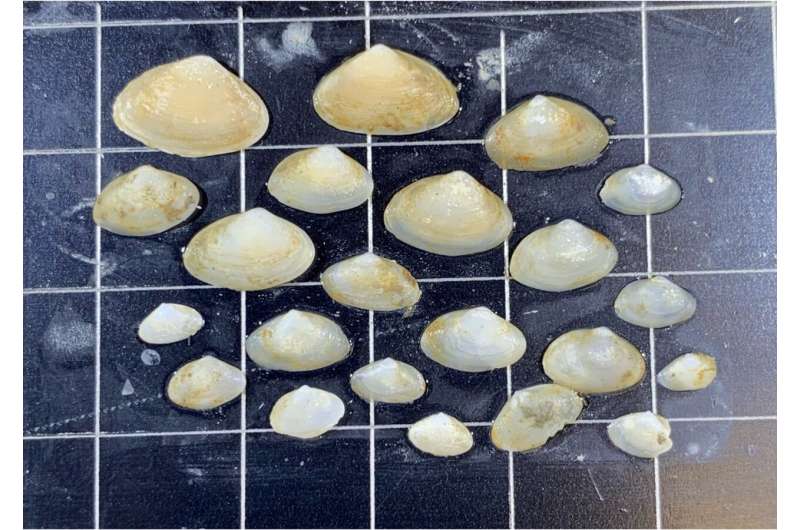Environment scientists close in on 'golden spike' to define Anthropocene

Leicester researchers searching for a "golden spike" to formally define humanity's current geological period—and acknowledge human impact on our planet—have announced a major step in their analysis at an international conference on Wednesday.
University of Leicester Professors Jens Zinke, Mark Williams and Jan Zalasiewicz and Ph.D. researcher Stephen Himson presented multiple candidates for unique reference points to define the Anthropocene at Haus der Kulturen der Welt's "Unearthing the Present" conference in Berlin.
The Anthropocene—the suggestions that human impact has driven Earth into the conditions of a new geological period or "epoch"—has been one of the most influential concepts of the last decade in geological research, with Leicester researchers playing a leading role in its analysis.
Search for a "golden spike" is a key concept in Anthropocene study, which would provide a unique reference point—chosen somewhere in the world—to mark the beginning of the Anthropocene, that might ultimately allow it to be formally defined as part of the Geological Time Scale.
Researchers' attention is focused on the mid-20th century, a transformational "Great Acceleration" in our planet's history that included massive burning of fossil fuels and its climate effects, the worldwide spread of human-made radioactive elements such as plutonium and of plastic debris and other pollutants, as well as rapid and dramatic changes to Earth's ecosystems.
Currently, research teams are making detailed studies of a dozen potential sites around the globe, ranging from a core of Antarctic snow and ice, to a peat bog in Poland, to a stalagmite deep underground in the Italian Alps.
Among the candidate sites are two being studied by University of Leicester teams: a living coral on Australia's Flinders Reef, the annual growth layers of which are being analyzed by a team led by Professor Zinke of the School of Geography, Geology and the Environment; and the mud layers of San Francisco Bay, studied by a team led by Stephen Himson and Professor Williams within the same School, which contain a biological chronometer in the form of the remains of many recently invasive organisms in the Bay.
The full list of candidate sites includes:
- Beppu Bay (marine sediments), Kyushu Island, Japan
- Crawford Lake (lake muds), Ontario, Canada
- Ernesto Cave (cave deposits), Italy
- Flinders Reef (coral), Coral Sea, Australia
- Gotland Basin (marine sediments), Baltic Sea
- Palmer Ice Core (ice sheet), Antarctic Peninsula
- San Francisco Estuary (marine sediments), California, U.S.
- Searsville Reservoir (lake muds), California, U.S.
- Sihailongwan Lake (lake muds), Jilin province, China
- Śnieżka Bog (peat layers), Poland
- Vienna Museum Excavation (urban soil), Austria
- West Flower Garden Bank (coral), Gulf of Mexico
Results of these studies were unveiled for the first time at the meeting in Berlin, to begin the discussion of which of these sites might have the most precise and complete record of Earth's global changes, to allow it to represent the Anthropocene's chosen beginning.
Announcement of these results are a major new development in study of the Anthropocene, and the potential springboard to its acceptance as a universally acknowledged new phase in our planet's history.
Over the five days of the Berlin event the scientists will also interact with artists, scholars, activists and the public in open discussion forums, via a series of online essays on various kinds of human impact, and by the opening of an exhibition, Earth Indices. This will provide unique insights into the processes of developing a geological archive of humans' home planet.
Professor Zinke, whose research examines the role of massive corals and sedimentary archives from tropical oceans as recorders of environmental change, says that "coral provide the highest resolution archive of anthropogenic impacts on the tropical oceans and they do that over several centuries of continuous upward growth."
"Massive corals at Flinders Reef provided a continuous record of environmental change for more than 300 years, starting in 1710, giving us information how anthropogenic activity has modified the environment in remote coral reefs."
"The Flinders Reef corals recorded a clear spike in radiocarbon between 1959 and 1963 short after the nuclear bomb testing began in the 1950s. This is a unique signature of the Anthropocene."
"The burning of fossil fuels has left a clear signature in the coral skeleton in their isotopic composition of Carbon which started to decline around 1850. The coral show us that light carbon from fossil fuel burning has been taken up by the surface oceans."
Professor Williams, whose work focuses on human-induced changes to life and how human-built environments affect the delicate balance of natural ecosystems on our planet, says that "the ecosystem of the San Francisco Estuary has been wholly changed by organisms introduced from as far afield as Japan."
"Sometimes the new arrivals completely dominate their adopted ecologies, their shells accumulating in the recent fossil record and leaving a clear geological signature of human impacts on the planet."
"Although San Francisco Estuary is very well studied, the same patterns, from introduced species, are becoming widespread on our planet."
The Leicester research team have also contributed to a feature on their findings, "Biological and Palaeontological signatures of the Anthropocene," published by Anthropocene Curriculum.
More information: Publication: www.anthropocene-curriculum.or … -of-the-anthropocene
Provided by University of Leicester




















